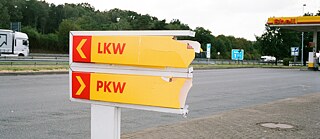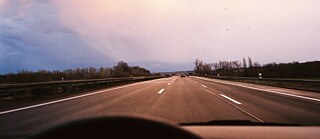Jan Künemund Idyllic wilderness or the rest stop

Need to stretch your legs, have a quick espresso or pop to the loo? That’s by no means all that happens at motorway services and lay-bys. Such rest areas lead a secretive double life: in the gay scene they are known as cruising spots where people meet to have sex. Jan Künemund has documented the history of motorway services as places of sexual dissidence.
Elfriede Jelinek in: “Service Area or They’re All Doing It”
“i’d just like to ask you to take your rubbish away with you !!! thanks”
Tomas001 on gay.de writing about the commuter car park on the A4 motorway, Düren exit
Erzkaul, Bucheneck, Mönchberg, Am alten Hau, Löwenburg, Fuchsgrund, Höllenplacken. These enticingly romantic-sounding rural names refer to motorway services or lay-bys in Germany, some of them boasting a variety of eateries and sanitary facilities, which probably have their roots in the Nazi’s plans for the “Reichsautobahn”, a concept that romanticized the stress and arduous nature of lengthy car journeys by offering drivers the prospect of being able to take a rest break at any time close to sights of natural or historical interest.
At the Gay Museum in Berlin, which is home to an open-access archive of the queer community, these names appear in files entitled “HS [homosexuality] as an offence”. In the gay scene, motorway service areas, lay-bys and car parks are known as cruising spots where people meet to have sex. And the archive contains reports from regional newspapers that document such activities from a “concerned citizen’s” perspective. In the reports, the romantic idyll of Germany’s Autobahn seems sullied, besmirched. The forest adjacent to the Erzkaul rest area is becoming a “tip”, while the lay-by itself has acquired a “sleazy image”, and “smutty items” have been discovered in the various car parks at the “Walldorfer Kreuz” junction (condoms, paper tissues, lubricant packaging and naked photos); at the “Am alten Hau” lay-by this litter has even attracted wild boar.
Almost all of the reports focus on environmental pollution rather than highlighting any moral concerns about unconventional sexual practices. And although one can of course conclude therefore that concepts of cleanliness and tidiness are being jeopardized here, the core message appears to be that there is confusion about the ways in which public or semi-private space should be used. Motorway services and lay-bys are intended as rest areas for car drivers, not as places for anonymous sex nor to provide a source of food for wild animals. The “offence” occurs when these delineations become blurred – or even overlap: the married woman who is on the way somewhere but meets up with her lover at the car park; the heterosexual trucker who gives someone a blow job in the public toilets; the wild boar that briefly leaves the forest to devour the half-eaten chocolate bar.
The public sphere as a locale for physical intimacy
Finding innovative places in which to have sex is not infrequently viewed as a cultural peculiarity of the queer scene. The tradition that has rendered this group structurally invisible has led to their devising original strategies by which to make themselves visible at least to one another. Cruising maps out public spaces according to the respective forms of desire and ignores their official rules and designations. The anonymous public sphere can become a place of physical intimacy and privacy in an exciting game of visibility and invisibility, safety and danger, shame and pride. Knowledge about these locales is shared informally, with supervisory authorities, concerned citizens and regional newspapers tending to find only the traces left behind by these thrilling encounters. All cruising sites, be they toilets, dark rooms, beaches, parks, swimming pools or the basements and back rooms of bars, have specific idiosyncrasies and characteristics. So why pick motorway service areas such as Erzkaul, Mönchberg and Höllenplacken?Sex and local recreational activities
The cruising ecosystem requires public infrastructure: main traffic arteries, easy access, escape routes, architectures that allow one to switch from one realm to another. Looking at the collectively compiled lists of motorway cruising sites (classified – though not always – according to gays, voyeurs and couples) that can be found relatively easily online, it becomes clear that it is not so much the commercial motorway services that are “where the action is”. Mostly, it is car parks and lay-bys (sanitary facilities being an advantage but not a necessity) next to areas of countryside, such as woodland, fields, expansive meadows, the shores of a lake, bushes or big trees behind which one can hide. This is a game that involves visibility and concealment. Then there are the codes: different colours of ribbon tied to a car antenna or precise instructions, affixed to the underside of the lids of specific rubbish bins, about where to find that day’s particular sex locus – though potentially anyone may spot these clues, they can only be understood by the initiated. Different spheres are used for making contact, engaging in the “activities“ themselves and even for resting after “the chase”: the private spaces afforded by cars and lorries, the public spaces that are the toilets, and any points in between.In the early 1990s, John Hollister [1] conducted sociological research on the use of motorway service areas in the USA as places for cruising and discovered that there – unlike in dark rooms or “cottages” – verbal communication is engaged in more frequently, with a bit of small talk about the weather, for instance. For some car parks, community listings may recommend walks (to look at the stars) or areas where one can lie down and relax. Once again, the different realms overlap here: that which involves establishing contact with a view to having sex, and that which entails local recreational activities. Naturally, car parks are not always safe cruising spaces, as haters also find out where they are and learn the codes. Attacks are not infrequent, and an attempted murder at the Höllenplacken car park (on the A6 motorway near Kaiserslautern) in 2006 was reconstructed for the ZDF’s crime-solving television programme Aktenzeichen XY.
Motorway services as non-places and anti-places
The journalist Florian Werner, in keeping with New Journalism’s traditional pursuit of the “fine art of hanging around”, spent quite some time at the Garbsen Nord motorway services in the summer of 2019 to record observations and interviews for his book Die Raststätte – Eine Liebeserklärung (The Motorway Services – A Declaration of Love). He didn’t encounter any cruising activities there, or at least did not notice anything of the kind from his uninitiated perspective. However, a chief superintendent from the local motorway police did tell him about a car park that had been frequented by the homosexual scene in the past.Werner’s cultural scientific research into the characteristics of motorway services and lay-bys points to a number of reasons why these are very well suited as places for sexual dissidence. These include the way the (non-)place is detached from its surrounding environment (or, to put it in queer terms: the lack of social control), its heterotopic nature (as an anti-place for everything rejected by conventional society), its spatial hybridity (offering at once privacy, for example to pursue one’s own desire, and publicness, for example to find potential sex partners) and its lack of identity: nobody associates a visit to a lay-by or motorway services with the history or regional traditions of the site and it says nothing about who or what one is.
Truckers and hitchhikers
Motorway services are subcultural contact zones for people in transit and it’s difficult to pinpoint any precise definition. In gay porn, trucker fantasies are a genre in their own right, the protagonists being the hitchhiker who is in the process of sexually maturing and the truck driver whose identity is all about being in perpetual motion, without origin or destination. Truckers belong to the fetish cosmos of the illustrator Tom of Finland. The “one-handed literature” listed in the Gay Museum’s library catalogue includes books with titles such as Autobahn Brothers (Ace Brunner) or Trucker Dreams (Janos Solko).The motorway services are points of intersection that promise new and auspicious encounters: “This is Vince, he’s travelling to Istanbul with me, is there any space for us at your table?” The same is true of swinger fantasies in the hetero scene: in Elfriede Jelinek’s theatre play Service Area or They’re All Doing It (2002), two married women want to meet up with animals they have contacted online. This sees the dissident human and animal cartography of the lay-by overlap in a way that is just as interesting as the fear of wild boar being lured in by gay cruising.
Cruising in an era of dating apps
“Fortunately, homosexuals no longer need to meet in dark corners at lay-bys,” believes the motorway police superintendent in Florian Werner’s declaration of love to the motorway services. He is referring no doubt to the greater social acceptance of homosexuals, who nowadays no longer meet in heterotopias but can make contact with one another in the midst of society. Others would describe dating apps as the nails in the coffin of the cruising culture; because of them, one only sets off for an encounter once pics have been exchanged, a place and time agreed, and the type of sexuality one happens to be in the mood for determined.Indeed the cruising culture is changing all the time (how does cottaging work in an age of automated pay toilets?), yet on warm summer nights hundreds of people can still be found cruising for sex in Berlin’s Tiergarten park, and the collective lists of cruising car parks are still fairly up-to-date. Perhaps it is precisely the unpredictability of the encounters that makes the difference, the intimacy with people from other worlds that is made possible without dating filters and all-encompassing agreements, irrespective of identity, race, class, age and orientation. On the verges of motorways on which productive people are single-mindedly travelling towards their destinations we find spaces for desire that are not supposed to be there and in which unpredictability is all part of the game. They require no institutional legitimation.
directions: Lonetal lay-by directly on the A7 between Heidenheim and Ulm
Best times: from 1 am to 3 am
Characteristics: Unfortunately there’s a services directly next to it, so lots of people. But that doesn’t bother us!”
anonymous, Google group
Leap (Ed.): Public Sex/Gay Space. New York 1999 (= Between Men-Between Women:
Lesbian and Gay Studies), p. 55–70.


